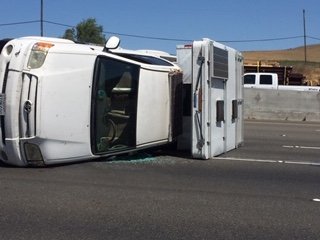ALLAN BRILL
New Member
- Joined
- Jul 13, 2016
- Messages
- 7
Greetings Wandering Brothers & Sisters.
From my sad experience (see attached photo of my FWC after accident), I can say that even without the approximate 5" lift flat beds generally require above my 2004 Tundra 4WD Double Cab stock bed, COG can be a problem. My platform for the FWC raised the camper 3" above the sides of the bed unnecessarily, which I believe increased the COG height enough to make the swerve less controllable. I avoided a car swerving into my rig but couldn't control the resultant sway/instability. The oncoming, thundering 18-wheelers scared but avoided me despite the 3 blocked lanes!
I am considering a flat bed to replace the damaged stock one on my Tundra, so I can add boxes for storage & carry bikes/gas cans in front of my my current 2013 Hawk slide-in. The mass produced flat beds I've seen sit above the tires, and raise the COG between 3-6 inches above the stock beds depending on model & different estimates. As you can imagine, since I escaped the recent tip-over with little damage (though the camper was totaled and truck took substantial repair), I'm grateful and not feeling like risking anything like that in the future. BTW I've added a sway bar, heavier duty Bilsteine 1500 shocks, and airbags to assist with stability.
SOOOO...anyone have any experiences, leads, expertise or understanding about these issues? Have others you know of endured turn-overs as pictured below? I've been unable to find a mass produced or affordable custom flat bed that can actually anchor directly to the Tundra base & around the wheels, and thus keep the COG lower. I'm a newbie to these issues, so any tips or opinions much appreciated!
Allan
From my sad experience (see attached photo of my FWC after accident), I can say that even without the approximate 5" lift flat beds generally require above my 2004 Tundra 4WD Double Cab stock bed, COG can be a problem. My platform for the FWC raised the camper 3" above the sides of the bed unnecessarily, which I believe increased the COG height enough to make the swerve less controllable. I avoided a car swerving into my rig but couldn't control the resultant sway/instability. The oncoming, thundering 18-wheelers scared but avoided me despite the 3 blocked lanes!
I am considering a flat bed to replace the damaged stock one on my Tundra, so I can add boxes for storage & carry bikes/gas cans in front of my my current 2013 Hawk slide-in. The mass produced flat beds I've seen sit above the tires, and raise the COG between 3-6 inches above the stock beds depending on model & different estimates. As you can imagine, since I escaped the recent tip-over with little damage (though the camper was totaled and truck took substantial repair), I'm grateful and not feeling like risking anything like that in the future. BTW I've added a sway bar, heavier duty Bilsteine 1500 shocks, and airbags to assist with stability.
SOOOO...anyone have any experiences, leads, expertise or understanding about these issues? Have others you know of endured turn-overs as pictured below? I've been unable to find a mass produced or affordable custom flat bed that can actually anchor directly to the Tundra base & around the wheels, and thus keep the COG lower. I'm a newbie to these issues, so any tips or opinions much appreciated!
Allan

